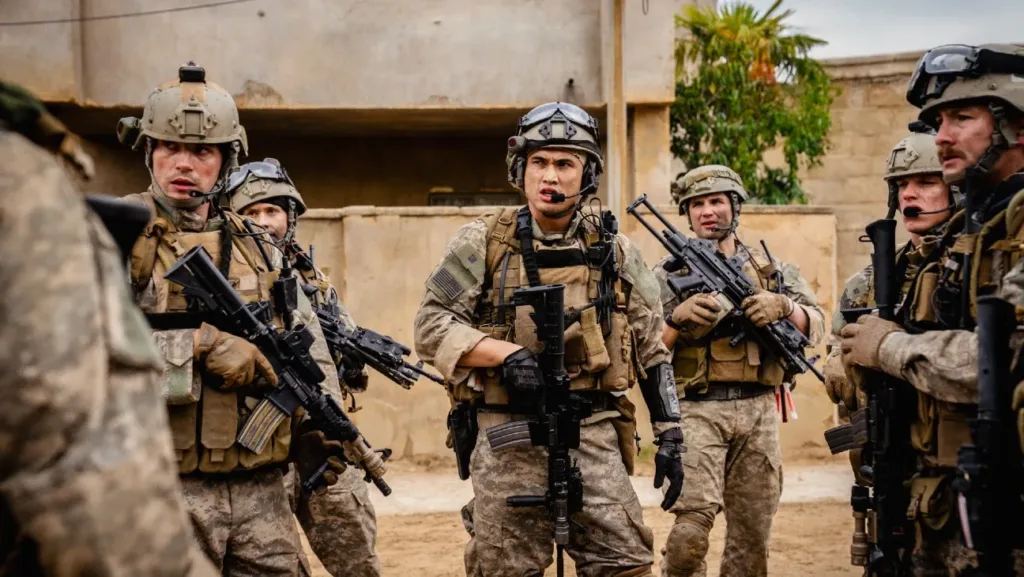Warfare, co-directed and co-written by Alex Garland and Ray Mendoza, draws from firsthand accounts of a Navy SEAL mission in Ramadi, Iraq, in November 2006. The script is based entirely on the memories of Mendoza and his fellow SEALs, offering a close-up view of an overnight surveillance operation that shifted into active conflict.
The film begins with a unit of Navy SEALs splitting into three teams. Their task: occupy a residential building under cover of darkness to observe enemy movement and secure the area for incoming ground forces. The mission, carried out in a region known for Al Qaeda activity, unfolds in confined interior spaces with little exposition and minimal dialogue. Military jargon is used without translation, and characters are shown as coordinated parts of a functioning team rather than as individually profiled figures.
The cast includes D’Pharaoh Woon-A-Tai as a young Ray Mendoza. Woon-A-Tai gained attention for his work on Reservation Dogs, and has also appeared in Hell of a Summer, Beans, and Creeped Out. Cosmo Jarvis plays sniper and medic Elliott Miller. Mendoza has dedicated the film to the real Miller. Jarvis’s past work includes Shōgun, Persuasion, and Lady Macbeth. He is attached to an upcoming adaptation of The Odyssey directed by Christopher Nolan.
Will Poulter appears as Eric, one of the team leaders. He was recently seen in Death of a Unicorn and stars in the upcoming film On Swift Horses. His earlier roles include The Maze Runner, We’re the Millers, and The Voyage of the Dawn Treader. Joseph Quinn portrays Sam, based on Joe Hildebrand, a SEAL who was seriously injured during the operation. Quinn is known for his role in Stranger Things and will appear in Gladiator II, The Fantastic Four, and a Beatles biopic as George Harrison.
Charles Melton plays Jake Wayne, officer in charge of the second team. Melton has appeared in Riverdale, May December, The Sun Is Also a Star, and Bad Boys for Life. Noah Centineo plays Bryan, a gunner in the squad. His filmography includes To All the Boys I’ve Loved Before, The Recruit, Dream Scenario, and Black Adam. Taylor John Smith plays sniper Frank, following previous roles in Where the Crawdads Sing, Sharp Objects, and Wolves.
Kit Connor appears as Tommy, another gunner. Connor is widely known for his role in Heartstopper and for appearing in Romeo + Juliet on Broadway alongside Rachel Zegler. Michael Gandolfini plays Lt. MacDonald. His credits include The Many Saints of Newark, The Deuce, and Beau Is Afraid. He is also set to appear in Daredevil: Born Again.
Adain Bradley plays Sgt. Laerrus. Bradley has worked on Tarot, Industry, The 100, and All American. Across the cast, the characters are introduced without personal backstories or distinct narrative arcs. Dialogue is functional. Emphasis remains on group coordination, decision-making under pressure, and movement through the environment.
Most of the action takes place in real time. Scenes of waiting and surveillance are drawn out, leading to a sudden grenade attack that signals enemy awareness. The pace shifts without warning, pushing the team into response mode. Physical damage is shown without dramatic enhancement. When injuries occur, the film holds on them, refusing to soften or obscure their effects.
Garland and Mendoza keep the perspective locked to the soldiers’ experience. The presence of Iraqi civilians appears only briefly, as the SEALs move through their building and take up positions. Quick shots of families in hiding or insurgents firing from rooftops mark their surroundings but are not elaborated upon.
Garland, known for Civil War, previously worked with Mendoza on that film, where Mendoza served as a military adviser. In Warfare, their collaboration extends to direction and script. The film avoids grand speeches or narrative commentary. It presents actions and consequences as experienced, relying on sound, pace, and framing rather than traditional plot structure.
The project does not include monologues, explanations, or cutaways. Each moment is tied to what the unit sees and hears. There is no external narration or editorial framing. The intent is to simulate a real operation as it was remembered by those who lived it.
